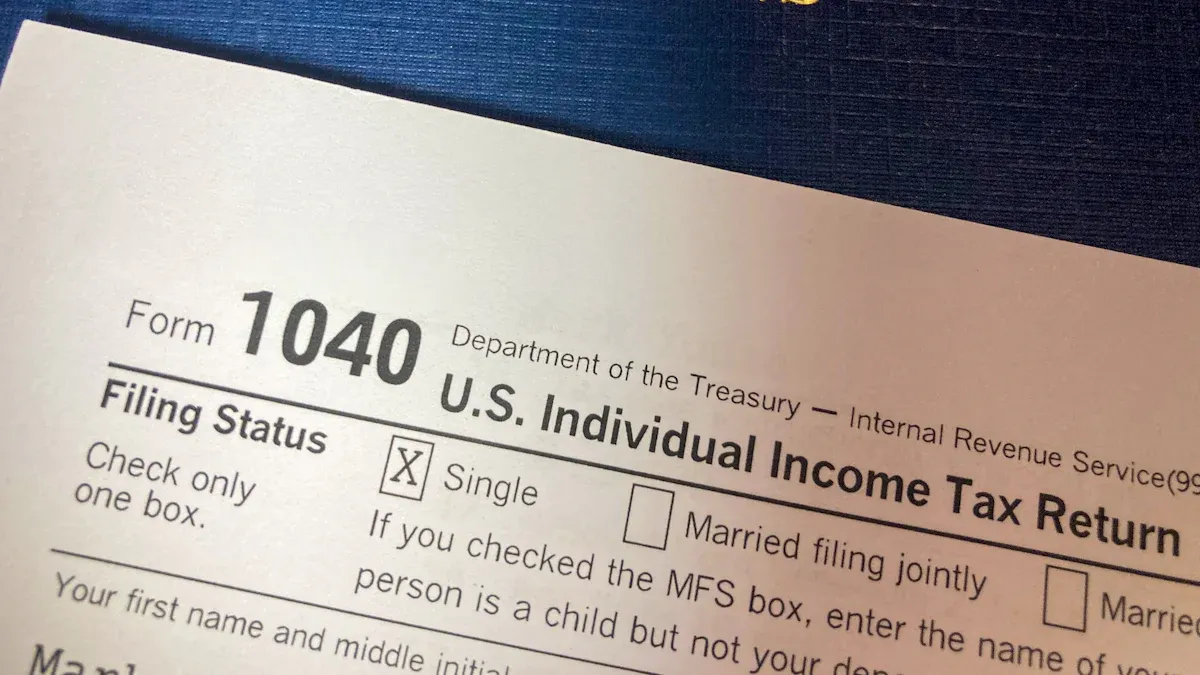- EasyCard
- Trade
- Help
- Announcement
- Academy
- SWIFT Code
- Iban Number
- Referral
- Customer Service
- Blog
- Creator
2025 China U.S. Stock Investment: Account Opening and Tax Guide

Image Source: pexels
Investing in U.S. stocks presents Chinese investors with three main challenges. First, without a U.S. Social Security Number, many U.S. brokers impose strict requirements, making account opening difficult. Second, tax reporting is complex, involving dividends, interest, capital gains, W-8BEN forms, and ITIN validity. Finally, compliance risks are significant; false information or proxy account services can lead to frozen funds or IRS investigations. Prioritizing compliance ensures your funds remain secure.
Key Points
- Choosing the right account structure and broker reduces tax burdens and ensures fund safety.
- Prepare accurate identity documents and follow online account opening steps to start investing after approval.
- Understand U.S. stock investment taxes—dividends, capital gains, and interest—and report global income to avoid risks.
- Apply for an ITIN only when necessary for tax reporting to avoid complicating asset transfers.
- Adhere to legal compliance, avoid proxy account services, and regularly check account security for a smooth investment process.
Account Opening Process

Image Source: pexels
Account Structure Selection
When opening a U.S. stock account, you must first choose an account structure: individual, joint, or corporate. Each impacts fund safety and tax reporting:
- Individual Accounts: Simple to manage, ideal for most investors.
- Joint Accounts: Suitable for family asset management, offering high liquidity.
- Corporate Accounts: Best for large funds or complex tax planning needs.
Opting for accumulating funds (non-dividend-paying) can reduce tax burdens, as dividends incur income tax. Accumulating funds reinvest profits, minimizing cash outflows and taxes. Global income above $1 million USD triggers mandatory reporting in China, despite a 2024 overseas income exemption increase to $7.5 million. Structured products may offer tax advantages but have lower liquidity and different risks. Assess your needs carefully.
Note: Tax-saving tools reduce reported income, potentially affecting loan approvals, as banks may view lower income as insufficient cash flow.
Broker Types
You can invest in U.S. stocks through international brokers or entrusted platforms, each with distinct features:
- International Brokers (e.g., Firstrade, IBKR): Many, like Firstrade, offer zero-commission trading, ideal for small investors. Access over 8,000 U.S. companies with flexibility and features like automatic dividend reinvestment (DRIP) for no-fee compounding. Fund transfers are slower, taking days to reach Hong Kong banks, with wire fees of ~$25–40 USD (varies by exchange rate).
- Entrusted Platforms: Charge $20+ per trade, less favorable for small investors. They offer fewer investment options and lack DRIP. Funds stay in Hong Kong banks for easier access, but long-term costs are higher due to fees.
Some Chinese brokers (e.g., Futu, Tiger, Longbridge) require proof of overseas residency/work, while others accept offshore bank cards (Hong Kong, U.S., or Singapore). U.S. brokers like Interactive Brokers (IBKR) and Firstrade require no such proof. All are regulated by the SEC and covered by SIPC insurance, ensuring investment safety.
Required Documents
To open a U.S. stock account in 2025, prepare:
- Valid passport (or ID front/back), with a signed passport signature page uploaded.
- Mobile number for SMS verification.
- Valid email address.
- English residential address (use tools like Taiwan Post’s address translator).
- Personal details: name, address (in English), city, etc.
- Investment experience and financial status (e.g., goals, experience).
- Digital signature and account password setup.
- Await approval to complete opening.
An ITIN (Individual Taxpayer Identification Number) is relevant in 2025. Apply only if needed for tax reporting or exemptions, as it may complicate asset transfers. ITINs are valid for 5 years, and mismatched TAX IDs during transfers can lead to rejections. Avoid providing an ITIN unless necessary.
Account Opening Steps
Follow these steps to open a U.S. stock account:
- Choose a broker (e.g., Firstrade, IBKR, eToro).
- Gather required documents.
- Visit the broker’s website or app and select “Open Account.”
- Fill in personal details and upload passport/ID.
- Complete mobile and email verification.
- Answer investment experience and financial status questionnaires.
- Provide a digital signature and set a password.
- Await broker approval (1–3 business days).
- Link a Hong Kong or offshore bank account for initial funding.
Tip: Some brokers (e.g., Charles Schwab) have removed the $25,000 minimum deposit, lowering the entry barrier.
Common Issues
You may encounter these issues during account opening:
- Failed Document Review: Ensure passport/ID images are clear and match provided details.
- Identity Verification Issues: Most brokers offer Chinese-language support. Contact Charles Schwab’s Chinese hotline (00801-13-6758) during Taiwan business hours for assistance.
- Funding Restrictions: Many brokers have eliminated high deposit thresholds. Choose these to reduce financial pressure.
- ITIN Concerns: Avoid providing an ITIN unless required for tax purposes to prevent transfer complications.
Recommendation: Select brokers with low fees, Chinese support, and user-friendly interfaces for a better experience and enhanced fund safety.
Broker Comparison
Account Opening Thresholds
When selecting a broker, evaluate entry requirements. Firstrade and IBKR are accessible to Chinese investors, with simple processes and no high initial deposit requirements. China Construction Bank (Asia) demands higher financial proof, suiting larger investors. Beginners should opt for intuitive platforms like Yuanta Securities’ user-friendly app. High-net-worth investors may prefer brokers with ample stock availability and short-selling support to minimize trading restrictions.
Fees and Services
In 2025, zero-commission trading is standard, driven by Robinhood and adopted by Fidelity and Charles Schwab. Washington Securities offers 180 days of commission-free U.S. stock trading, options as low as $0.2 per contract, and perks like cash vouchers and new share subscriptions. Some brokers support virtual asset trading and direct USD/HKD deposits, reducing exchange costs. Frequent traders benefit from zero-commission brokers, while beginners can leverage free stocks and cash incentives for better returns.
Compliance and Security
Fund safety is paramount. Brokers like Tiger Securities are SEC-regulated, with client assets held by third-party banks, inaccessible without authorization. SIPC insures up to $500,000 ($250,000 cash) in case of broker insolvency. Tiger Securities adds Lloyd’s of London insurance up to $30 million. Internet brokers use smart pricing and low-latency systems, boosting efficiency and reducing costs.
Note: Choose SEC-regulated, SIPC-insured brokers to minimize risks and ensure investment security.
U.S. Stock Investment Strategies
ETF Dollar-Cost Averaging
In 2025, consider dollar-cost averaging with ETFs to spread risk, especially during volatile markets or black swan events. Diversify across regions (U.S., Europe, Asia) and sectors (tech, healthcare, energy). ETFs inherently diversify. Invest gradually over a year to mitigate timing risks and avoid missing market upswings. A 60% stock ETF and 40% bond ETF portfolio reduces losses and stress during downturns. Global diversification may increase costs but boosts long-term returns.
Tip: Consistent, disciplined investing outperforms lump-sum bets.
Dividend Stock Selection
For stable passive income, select dividend stocks like those in the Dow Jones High Dividend Index. These companies offer steady cash flow, ideal for long-term investors. High-dividend ETFs further diversify risk, enhancing stability.
Financial Report Analysis
Use platforms like Gurufocus for transparent financial data, including metrics, trends, institutional trades, and guru portfolios. Free features suffice for basics; advanced analysis requires membership. Track earnings weeks and economic events to stay informed.
Risk Management
In 2025, policy uncertainties, like U.S. trade policy shifts, impact markets. Analysts recommend maintaining stock exposure while allocating to quality bonds and gold for diversification. Adjust portfolios during volatility and gradually build AI-related holdings, a long-term growth sector.
Recommendation: Diversify and regularly review your portfolio to balance risk and reward.
Tax Reporting Process

Image Source: pexels
Tax Types and Obligations
U.S. stock investments involve three main taxes: dividend, capital gains, and interest taxes, each affecting your returns differently:
- Dividend Tax: U.S. brokers withhold 30% on dividends for stocks like NVDA or VOO (21% for TSM ADRs). In China, you report global income and can credit U.S.-withheld taxes against the 20% Chinese rate, requiring an additional 10% payment. High-income investors with a tax rate above 30% may opt for separate 28% dividend taxation to reduce burdens.
- Capital Gains Tax: The U.S. exempts non-residents from capital gains tax. In China, gains are treated as property transfer income, taxed at 20%, with a $32,000 USD (approx. ¥230,000) exemption threshold. Report only when annual global income exceeds this.
- Interest Tax: Interest from U.S. Treasuries or bond ETFs is reportable in China as global income, taxed per source location.
| Tax Type | Rate and Details |
|---|---|
| Dividend Tax | U.S.: 30% withholding (21% for TSM ADRs); China: 20% total, with U.S. credit (10% additional). Option for 28% separate taxation. |
| Capital Gains Tax | U.S.: Exempt for non-residents; China: 20% on gains, $32,000 USD exemption. |
| Interest Tax | U.S. Treasury ETF dividends or direct bond interest reported as global income in China. |
In China, you must:
- Report all global income, including dividends, interest, and gains. Domestic Chinese income is taxed separately under comprehensive income.
- Report global income exceeding $32,000 USD annually, included in the minimum tax regime.
- Offset same-category income within the same year; cross-category offsets are not allowed.
- Retain transaction and remittance records to distinguish principal from profits.
- Financial institutions report to tax authorities; income over $16,000 USD is trackable via CRS.
- The minimum tax regime taxes income above $215,000 USD at 20%, with foreign tax credits.
Note: Report based on income realization, not repatriation, to avoid heavy tax burdens when transferring large sums.
ITIN Application
Without a U.S. Social Security Number, you may need an ITIN for U.S. tax reporting, especially for rental income or capital gains:
- Complete Form W-7 with passport or ID documents.
- Apply via mail or through IRS-authorized agents.
- Receive approval at your Chinese address, usable as address proof.
- ITINs build U.S. credit history, aiding future banking.
- Some loan providers require ITINs, though not all foreign-focused programs do.
- Assess ITIN risks to avoid IRS violations.
Caution: ITINs are not mandatory for all investors. Apply only if needed to simplify compliance.
Tax Forms
Key tax forms for U.S. stock investments:
- W-8BEN Form: Declare non-resident status to ensure 10% dividend withholding (instead of 30%). Resubmit every three years.
- 1099 Form: Annual statement detailing dividends, interest, and gains, issued by brokers in late January/early February for Chinese reporting.
- W-7 Form: Required for ITIN applications with supporting documents.
Tip: Store all tax forms and transaction records for audits.
Tax Savings and Pitfalls
Maximize after-tax returns with these strategies:
- Check global income against the $32,000 USD threshold by May annually to avoid penalties.
- Retain transaction statements, funding records, and exchange rate proofs for cost and profit calculations.
- Offset same-category income within the same year; cross-category offsets are prohibited.
- Choose between comprehensive income reporting with an 8.5% credit or 28% separate dividend taxation based on your tax rate.
- Understand U.S. withholding and Chinese tax laws to optimize portfolios.
- Familiarize yourself with minimum tax regime calculations to avoid penalties.
- Consult financial advisors to adapt to market and tax policy changes.
Common pitfalls:
- You must self-report offshore broker income, as tax authorities don’t automatically track details.
- Even below the exemption threshold, report income. Exceeding $32,000 USD requires reporting; late filings inflate taxes upon repatriation.
- Accumulating unreported income over years leads to high taxes when repatriated, missing exemption benefits.
- Losses cannot offset future years’ gains, limiting tax relief.
- Large investors should consult accountants or tax lawyers to minimize risks.
Recommendation: Report proactively, retain records, and review investments regularly to avoid pitfalls and ensure compliance.
Compliance and Risks
Legal Operations
Adhere to regulations when opening accounts. Providing false information or using proxy services risks account freezes or trading bans. Ensure application details match your passport and bank records. Legal operations protect funds and prevent legal issues.
Warning: Avoid “proxy account” services, which are illegal and high-risk.
Information Exchange
In 2025, the CRS (Common Reporting Standard) mandates financial institutions to share non-resident account data. Hong Kong banks report to Chinese tax authorities, who can audit unreported income via CRS. Maintain transparent transaction and tax records to avoid disputes.
Avoiding Pitfalls
Beware of 2025 scams, including fake broker websites, phishing emails, or fraudulent customer service. Verify broker URLs and avoid suspicious links. “Guaranteed high returns” are often scams. If accounts are frozen or funds inaccessible, contact official broker support or seek professional help.
Recommendation: Enable two-factor authentication, store records securely, and verify account safety regularly.
For compliant U.S. stock investing in 2025, follow legal procedures, report taxes accurately, and stay informed via broker websites, Hong Kong bank support, or tax advisors. Consult professionals for clarity to ensure a secure investment journey.
Check IRS.gov, broker support, and Hong Kong bank resources for the latest updates.
FAQ
What if I don’t have a Hong Kong bank account for opening?
Apply for a Hong Kong virtual bank account (e.g., ZA Bank, WeLab Bank), which supports online opening and broker linking.
Is there a minimum deposit for U.S. stock brokers?
Most brokers (e.g., Firstrade, IBKR) have no minimum deposit. Check specific requirements, as some may still impose thresholds.
Can I report taxes without an ITIN?
Yes, use the W-8BEN form for broker withholding. An ITIN is needed only for U.S. tax refunds or specific filings.
How do I repatriate U.S. stock profits to China?
Transfer funds to a Hong Kong bank, then repatriate per Chinese forex rules. Retain trading and remittance records for compliance.
What if my account review fails?
Ensure document clarity and consistency. Contact the broker’s Chinese support for assistance with supplemental documents.
This article provides a comprehensive guide to the entire process of opening a U.S. stock account and filing taxes for Chinese investors, offering valuable tips to avoid common pitfalls. However, even with all the steps understood, transferring funds from China to an overseas brokerage account remains a critical challenge for many investors. Traditional bank wire transfers are not only expensive and cumbersome but also have unpredictable transfer times, which can be a major obstacle to seizing fleeting opportunities in the U.S. stock market.
Now, you can choose a financial tool designed specifically to solve these pain points. BiyaPay is committed to providing you with a one-stop global financial service. We support the conversion between various fiat and digital currencies and offer a real-time exchange rate query to ensure you get the best rate for every dollar you exchange. With remittance fees as low as 0.5% and same-day delivery, we significantly reduce your transaction costs and time. What’s more, our platform enables you to invest in both the U.S. and Hong Kong stock markets from a single account, all without the need for a complex overseas bank account. Say goodbye to complexity and embrace efficiency. Register with BiyaPay today to easily and compliantly manage your global assets.
*This article is provided for general information purposes and does not constitute legal, tax or other professional advice from BiyaPay or its subsidiaries and its affiliates, and it is not intended as a substitute for obtaining advice from a financial advisor or any other professional.
We make no representations, warranties or warranties, express or implied, as to the accuracy, completeness or timeliness of the contents of this publication.




Contact Us
Company and Team
BiyaPay Products
Customer Services
is a broker-dealer registered with the U.S. Securities and Exchange Commission (SEC) (No.: 802-127417), member of the Financial Industry Regulatory Authority (FINRA) (CRD: 325027), member of the Securities Investor Protection Corporation (SIPC), and regulated by FINRA and SEC.
registered with the US Financial Crimes Enforcement Network (FinCEN), as a Money Services Business (MSB), registration number: 31000218637349, and regulated by FinCEN.
registered as Financial Service Provider (FSP number: FSP1007221) in New Zealand, and is a member of the Financial Dispute Resolution Scheme, a New Zealand independent dispute resolution service provider.



















